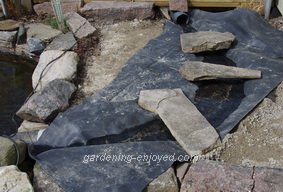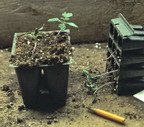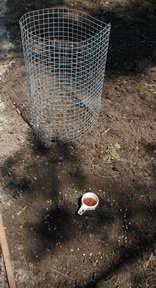| Back to Back Issues Page |
 |
|
Dallying In The Dirt, Issue #167 --- Yes, river building is a gardening activity. April 25, 2014 |

Good Friday was a good Friday for having a holiday but that made the day slip by before I even realized it was the day to publish "Dallying". Back to the schedule this week. I finally have the river running again but just barely. Lots of work to do around the river to recreate the path and make the area functional again but the water is flowing and the fish are happier. Without movement the water was quickly becoming cloudy and unpleasant and a couple of more fish made their way to that great pond in the sky. It has been running for 24 hours now and the water level does not seem to have dropped noticeably so we can hope that all of the connection points are water tight. We will still have to top up the ponds regularly during the summer as the waterfalls and rivers are basically a large evaporator. It was amazing to see the birds bathing in the rivers within hours of their return to movement. One of the fun things that make pond upkeep worth while is the birds.
They show up regularly, many different species, to splash and bathe in the shallow running water. It’s off to the fish store this weekend to restock the ponds. All large pet stores selling fish have a tank of feeder fish whose ultimate destiny is to be eaten by somebody’s bigger fish. They are always very inexpensive and they will grow to be quite a good size when given the ponds to live in. We get an interesting variety of colours, gold, white, black and mixtures of all three but they all provide the colour and movement and mosquito eating action that is required of my pond fish.  Down in the basement the space / time continuum continues to create its usual problems. The cold frame is filled with all of the early season vegetables. The weather has not let me plant them into the garden. The propagating bed is filled with Tomato, Pepper, Marigold and many other seedlings that need to be transplanted into their larger cell paks. The space under the lights is filling up with those things as I transplant them and some of them need to move out to the overflowing cold frame. It’s all supposed to flow smoothly but when the weather dares to not follow my careful calendar then great havoc ensues. If I can get the Peas into the ground then maybe I can also get
the Pak Choi and Broccoli out of the cold frame and into the garden. The outdoor gardening season has barely begun and we are already busy planting seeds, transplanting and generally moving things about. The upside of the cool weather is the long season we are enjoying from the minor bulbs. The Crocus, Bulbous Iris, Scilla and others have lasted for an extended period of time with no warm weather to finish them off. Those classes were well represented at the local garden club flower show this week but the 10 Narcissus classes had a total of four entries, none of them mine.
Down in the basement the space / time continuum continues to create its usual problems. The cold frame is filled with all of the early season vegetables. The weather has not let me plant them into the garden. The propagating bed is filled with Tomato, Pepper, Marigold and many other seedlings that need to be transplanted into their larger cell paks. The space under the lights is filling up with those things as I transplant them and some of them need to move out to the overflowing cold frame. It’s all supposed to flow smoothly but when the weather dares to not follow my careful calendar then great havoc ensues. If I can get the Peas into the ground then maybe I can also get
the Pak Choi and Broccoli out of the cold frame and into the garden. The outdoor gardening season has barely begun and we are already busy planting seeds, transplanting and generally moving things about. The upside of the cool weather is the long season we are enjoying from the minor bulbs. The Crocus, Bulbous Iris, Scilla and others have lasted for an extended period of time with no warm weather to finish them off. Those classes were well represented at the local garden club flower show this week but the 10 Narcissus classes had a total of four entries, none of them mine.Now it’s time to answer a few of my reader’s questions. Don’t forget to check the front page of the Website for frequent short ideas for current gardening activities. Shirley Asks?
Are semperflorens and fibrous begonias the same plant. |
| Back to Back Issues Page |
 Despite the continuing cool weather the soil is drying and there is some hope that we might get the
Despite the continuing cool weather the soil is drying and there is some hope that we might get the